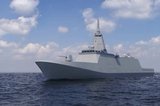Philippines orders naval-specific MiniPOP variant for patrol boats
MiniPOP for Maritime Applications EO from IAI is being installed on PN patrol boats of an undisclosed type (pictured is a graphic of the Shaldag Mk V). (Image: Israel Shipyards)
Israel Aerospace Industries (IAI) is to provide its MiniPOP for Maritime Applications EO system for installation aboard Philippine Navy (PN) patrol boats.
The Israeli company did not divulge the value of the contract or delivery timeframe when announcing the deal on 16 May.
Nor did IAI mention which type of patrol boats would receive the EO systems, although it is worth noting that Israeli industry is already providing other sensors for the eight Shaldag Mk V patrol boats that the PN ordered in January 2021 from Israel Shipyards.
IAI described MiniPOP for Maritime Applications as a ‘lightweight and compact multi-sensor observation system’ specifically for naval vessels.
‘The payload provides real-time imaging, automatic video tracking, and precise target geo-location capabilities that can be used as a stand-alone EO/IR observation system on small and medium-sized vessels,’ IAI added.
IAI president and CEO Boaz Levy noted ‘other recent deals between IAI and the Philippine Navy’. One example is a contract (announced in April 2022) to equip two anti-submarine warfare corvettes with ELM-2258 ALPHA 3D radars.
Related Programmes in Defence Insight
Shaldag Mk V (1-9) [Philippines]
Related Equipment in Defence Insight
More from Naval Warfare
-
![NATO tests use of “undetectable, jam-proof” laser communication in maritime scenarios]()
NATO tests use of “undetectable, jam-proof” laser communication in maritime scenarios
As part of its effort to better prepare its capabilities for operations in contested and congested scenarios, NATO evaluated a Lithuanian ship-to-ship terminal designed to not be susceptible to enemy interference.
-
![Mitsubishi eyes future with Australia’s Mogami selection]()
Mitsubishi eyes future with Australia’s Mogami selection
With Australia’s selection of the Mogami-class for Project Sea 3000, Mitsubishi is investigating local production in the next decade as potential export opportunities emerge.
-
![Hanwha wins Australian government approval to increase its stake in Austal]()
Hanwha wins Australian government approval to increase its stake in Austal
The contract would mean the two shipbuilders can collaborate strategically and enhance shipbuilding capabilities in Western Australia.






















